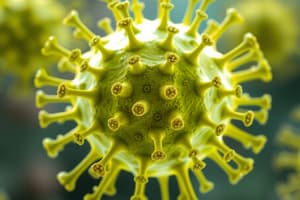Podcast
Questions and Answers
Which methods are commonly used in viral diagnosis?
Which methods are commonly used in viral diagnosis?
- Complement fixation
- Hemagglutination inhibition
- PCR
- All of the above (correct)
How is PCR used in viral diagnosis?
How is PCR used in viral diagnosis?
PCR detects viral genomes, quantifies viral load, and characterizes viral mutations.
List 7 human coronaviruses.
List 7 human coronaviruses.
HCoV-229E, HCoV-OC43, SARS-CoV-1, HCoV-NL63, HCoV-HKU1, MERS-CoV, SARS-CoV-2.
What are some advantages of using PCR in viral diagnosis?
What are some advantages of using PCR in viral diagnosis?
ELISA is used primarily for detecting viral genomes.
ELISA is used primarily for detecting viral genomes.
What are common diagnostic strategies for influenza?
What are common diagnostic strategies for influenza?
Describe the structure of the coronavirus.
Describe the structure of the coronavirus.
What are some risk factors for severe COVID-19 disease?
What are some risk factors for severe COVID-19 disease?
List one treatment for COVID-19 and its mechanism of action.
List one treatment for COVID-19 and its mechanism of action.
What are the main disadvantages of culture methods in viral detection?
What are the main disadvantages of culture methods in viral detection?
What is a common method of detecting SARS-CoV-2?
What is a common method of detecting SARS-CoV-2?
Match the viral diagnostic methods with their main characteristics:
Match the viral diagnostic methods with their main characteristics:
What are the major routes of viral transmission?
What are the major routes of viral transmission?
Define permissive cells and non-permissive cells.
Define permissive cells and non-permissive cells.
Define CPE (cytopathic effects).
Define CPE (cytopathic effects).
Define productive infection and abortive infection.
Define productive infection and abortive infection.
Define latent infection.
Define latent infection.
Define acute infection.
Define acute infection.
Define chronic infection.
Define chronic infection.
What is the main cause of continued measles activity in the developed world?
What is the main cause of continued measles activity in the developed world?
What is Baltimore's classification system?
What is Baltimore's classification system?
Explain how viruses are classified by ICTV.
Explain how viruses are classified by ICTV.
List each part of a virus' structure.
List each part of a virus' structure.
Describe icosahedral symmetry and helical symmetry.
Describe icosahedral symmetry and helical symmetry.
What is Transmission EM?
What is Transmission EM?
The two major routes of virus entry are _____ and _____ .
The two major routes of virus entry are _____ and _____ .
What are the 6 steps of virus replication?
What are the 6 steps of virus replication?
What is positive sense in single-stranded RNA viruses?
What is positive sense in single-stranded RNA viruses?
What is the role of structural proteins?
What is the role of structural proteins?
What are routinely used methods for virus culture?
What are routinely used methods for virus culture?
Describe principles of sample collection for diagnosing viral diseases.
Describe principles of sample collection for diagnosing viral diseases.
Flashcards are hidden until you start studying
Study Notes
Viral Transmission Routes
- Respiratory: Commonly transmitted by Rhinovirus, Coronavirus, Influenza A & B.
- GI Tract (Oral-Fecal): Transmission includes Norovirus, Poliovirus, Hepatitis A & E.
- Genital Tract: Viruses such as Papillomaviruses, Ebola, and Zika are transmitted.
- Conjunctiva: Enterovirus type 70, Ebola, and Zika can cause conjunctivitis.
- Blood (Parenteral): HIV and Hepatitis B are transmitted, often during vertical transmission.
- Vector Bite: Diseases such as Yellow fever, Dengue, and West Nile viruses are spread this way.
Cell Types in Viral Infections
- Permissive Cells: Cells that can support a productive viral infection.
- Non-Permissive Cells: Cells that cannot support a viral infection.
Cytopathic Effects (CPE)
- CPE refers to observable effects in host cells due to viral infection.
- Observations include changes in cell morphology (size, shape), cell fusion (syncytia), aggregations, and cell lysis.
Types of Viral Infections
- Productive Infection: Results in the production of infectious virions.
- Abortive Infection: Fails to produce infectious virions.
- Latent Infection: Non-infectious at first, but can become reactivated later.
- Acute Infection: Brief infection that usually resolves quickly but can lead to latency.
- Chronic Infection: Initial clearance followed by a persistent, stagnant infection.
Measles Activity in Developed Regions
- Continued outbreaks attributed to unvaccinated individuals traveling to/from affected regions.
- Controversy arose from Andrew Wakefield linking the MMR vaccine to autism.
Baltimore Classification System
- Classifies viruses into 7 groups based on replication and genome type:
- I: dsDNA
- II: ssDNA
- III: dsRNA
- IV: +ssRNA
- V: -ssRNA
- VI: reverse transcribing ssRNA
- VII: reverse transcribing dsRNA
ICTV Classification System
- Viruses are categorized based on physical and chemical properties through:
- Order (-virales), Family (-viridae), Subfamily (-virinae), Genus (-virus), Species.
- Employs a nonsystemic, polythetic, and hierarchical classification.
Virus Structure
- Composed of capsid, nucleocapsid, envelope, and virion:
- Capsid: Protein shell, shapes include icosahedral, helical, and complex.
- Nucleocapsid: Combination of capsid and nucleic acid.
- Envelope: Lipid bilayer from host; contains glycoprotein spikes for attachment.
- Virion: A complete virus particle.
Symmetry in Virus Structure
- Icosahedral Symmetry: Regular geometric pattern of capsomers; requires 12 pentons and hexons varying in number.
- Helical Symmetry: Identical subunits stacked in a helical arrangement; characterized by specific parameters like unit/turn and pitch.
Transmission Electron Microscopy (EM)
- Utilizes thin samples stained with metals to produce 2D images of viruses' interior, aiding in visualization.
Mechanisms of Virus Entry and Release
- Entry Mechanisms: Endocytosis (receptor-mediated) and fusion with the host membrane.
- Examples include Influenza (enveloped) and Adenovirus (naked).
- Release Mechanisms: Lysis (often cytolytic) and budding (enveloped viruses).
- Examples include Smallpox (lysis) and Influenza A (budding).
Virus Replication Steps
- Steps include attachment, entry, uncoating, genome replication, assembly, and release.
- Attachment Factors: Enhance virus entry but are not selective (e.g., heparan sulfate).
- Receptors and Co-receptors: Highly selective; essential for viral entry (e.g., CD4, CCR5).
RNA Virus Classification
- Positive Sense: Serves directly as mRNA.
- Negative Sense: Requires own enzyme to act as mRNA template.
- Replication varies for positive and negative sense, with retroviruses using reverse transcription.
DNA Virus Replication
- Single-stranded DNA (ssDNA) must convert to double-stranded DNA (dsDNA) for gene expression.
- Double-stranded DNA (dsDNA) typically uses host cell nucleus for replication and transcription.
Structural and Nonstructural Proteins
- Structural Proteins: Included in virions; consist of capsid, envelope proteins, and some enzymes.
- Nonstructural Proteins: Present only in infected cells and often have enzymatic functions.
- Retroviruses and negative-sense RNA viruses depend on carrying their own polymerase enzymes for replication.
Viral Culture Techniques
- Common methods include animal inoculation, chick embryo usage, and various cell culture types (primary, diploid, continuous).
- Plaque Assay: Quantifies infectious virus by counting plaques formed due to cell lysis.
Serological Assays for Viral Diagnosis
-
Techniques include ELISA, immunofluorescence, and latex agglutination.
-
ELISA: Utilizes antibodies for detection of antigens or antibodies in samples.
-
Immunofluorescence: Detects viral antigens in cells using direct or indirect methods.
-
Latex Agglutination Test: Detects antigen-antibody interaction using latex beads.### Viral Detection Techniques
-
Primary Antibodies: Two types are used in assays—one stains the host cell and the other stains the virus. Each antibody must be produced in distinct hosts.
-
Latex Agglutination Test:
- Detects antibodies or soluble antigens in saliva, urine, cerebrospinal fluid (CSF), or blood.
- Involves attaching antibody or antigen to latex beads; agglutination occurs if the corresponding partner is present in the sample.
- The technique is easy to perform and delivers a semi-quantitative result, essentially providing a simple yes or no answer.
- Faster than traditional methods using dyes, substrates, or enzymes.
PCR in Viral Diagnosis
-
Detection of Viral Genome: PCR identifies specific viral nucleic acids, enabling diagnosis without the risk of live virus propagation.
- Essential for viruses hard to detect by other methods, including HBV, HCV, and SARS-CoV-2.
- Applicable in small sample collections (ocular, amniotic fluid, CSF).
- Useful during antibody testing failures, particularly for HIV and HCV.
-
Quantification of Viral Load: PCR provides information on the quantity of viral genome, serving as:
- Diagnostic marker (e.g., CMV).
- Prognostic marker (e.g., CD4 count and viral load for HIV).
- Therapeutic marker to monitor treatment efficacy (e.g., HIV, HCV).
-
Characterization of Viral Genomes: PCR can also sequence viral genomes to identify mutations and track epidemiology.
-
Advantages of PCR:
- High sensitivity allows detection of minute amounts of viral RNA without needing to culture the virus.
- Provides rapid assessment of patient recovery.
- Detects mutations and emerging strains effectively.
Diagnostic Strategies for Specific Viruses
-
Influenza: Rapid tests identify nucleic acid without amplification; while PCR is common, rapid influenza tests yield lower accuracy.
-
HIV: Screening generally uses rapid tests or ELISA, with confirmation via Western blot. OraQuick provides results in 20 minutes.
-
HPV: Detection is performed using PCR targeting viral DNA.
-
Measles: Diagnosed using Enzyme Immunoassay (EIA), focusing on specific IgM post-rash onset.
Human Coronaviruses Overview
-
Seven Known Strains:
- HCoV-229E and HCoV-OC43 (common cold),
- SARS-CoV-1 (2003 outbreak),
- HCoV-NL63, HCoV-HKU1, MERS-CoV, and SARS-CoV-2 (COVID-19).
-
Structure:
- Coronaviruses feature a linear (+) single-stranded RNA genome and an envelope with spike glycoproteins vital for cell membrane fusion.
-
Pathogenesis:
- Commonly causes upper respiratory infections, with significant seasonal peaks.
- High prevalence by age six, predominantly transmitted through droplets.
- COVID-19 presents a significant danger post 3-10 days after infection.
SARS-CoV-2 Transmission and Risk Factors
-
Transmission:
- Person-to-person via respiratory droplets during coughing, sneezing, or conversation.
- Asymptomatic individuals can still spread the virus.
-
Risk Factors for COVID-19:
- Higher infection and severity rates in older adults and individuals with chronic diseases (e.g., cardiovascular issues, diabetes).
Challenges in COVID-19 Treatment
-
Severity Factors:
- COVID-19 can damage multiple organ systems (lungs, heart, kidneys, brain, intestines) leading to severe complications.
-
Immunopathogenesis:
- Viral replication triggers inflammation, increasing vascular permeability, cell damage, and attracting immune cells, resulting in symptoms such as pneumonia and acute respiratory distress syndrome (ARDS).
Drugs in COVID-19 Trials
- Hydroxychloroquine & Chloroquine: Anti-parasitics with potential viral effects.
- Favipiravir: Broad-spectrum RdRp inhibitor, efficacy questioned.
- Remdesivir: Nucleotide analogue targeting RNA viruses; previously developed for Ebola.
- Oseltamivir: Antiviral inhibiting neuraminidase.
- Thalidomide & Tocilizumab: Immunomodulators affecting cytokine response.
- Convalescent Plasma: Infusion of antibodies from recovered patients to mitigate disease severity.
Animal Models for SARS-CoV-2 Research
-
Mice: Economical for large studies but show no disease response to SARS-CoV-2.
-
Transgenic Mice: Adapted to express hACE2, enabling severe disease modeling not observed in humans.
-
Ferrets: Inconsistent reports on clinical illness show variability in disease manifestation.
-
Syrian Hamsters: Disease symptoms observed with virus clearance after a week.
-
Non-Human Primates: Virus replicates in lungs but practical limitations exist for use.
Detection Methods for SARS-CoV-2
- RT-PCR: High sensitivity due to amplification, though more expensive.
- ELISA & Plaque Assays: Common methods; specifics on performance not detailed.
- Lateral Flow Assays: Quick, cost-effective, but less sensitive compared to PCR.
- Culture: Direct virus detection; highly sensitive but slow, expensive, requiring specialized equipment.
Studying That Suits You
Use AI to generate personalized quizzes and flashcards to suit your learning preferences.



